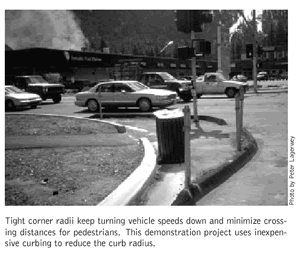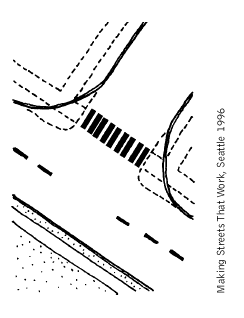9. Curb Radius Reduction
One of the common pedestrian crash types involves a pedestrian who is struck by a right-turning vehicle at an intersection. A wide curb radius typically results in high-speed turning movements by motorists. Reconstructing the turning radius to a tighter turn will reduce turning speeds, shorten the crossing distance for pedestrians, and also improve sight distance between pedestrians and motorists.
If a curb radius is made to small large trucks or buses may ride over the curb placing pedestrians in danger. Development type and types of road users should be considered when designing an intersection so that curb radii are appropriately designed.
Where there are no curb extensions and there is a parking and/or bicycle lane, curb radii can be even tighter, because the vehicles will have more room to negotiate the turn. Curb radii can in fact be tighter than any modern guide would allow: older cities in the Northeast frequently have radii of 2'-5' without suffering any detrimental effects.
More typically, in new construction, the appropriate turning radius is about 15' and about 25' for arterial streets with a substantial volume of turning buses and/or trucks. Tighter turning radii are particularly important where streets intersect at a skew. While the corner characterized by an acute angle may require a slightly larger radius to accommodate the turn moves, the corner with an obtuse angle should be kept very tight, to prevent high speed turns.


Purpose:
- Safer intersection design.
- Slow right-turning vehicles.
- Improve pedestrian crossings by reducing crossing distances and improving visibility between drivers and pedestrians.
- Shorter crossing distances can lead to improved signal timing.
Considerations:
- Consider effective radius by taking into account parking and bicycle lanes.
- Make sure that public maintenance vehicles, school buses and emergency vehicles are accommodated.
Estimated cost
Construction costs for reconstructing a tighter turning radii are approximately $2,000 to $20,000 per corner, depending on site conditions.